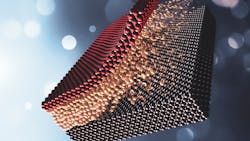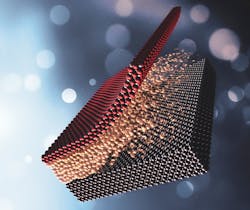Researchers Discover a New Way to Fine-tune Exotic Materials
One way engineers can change a material’s properties is to slightly stretch it so its atoms are farther apart, but the bonds between them don’t break. The extra distance affects the behavior of electrons, which determine whether the material is an insulator or a conductor of electricity, for example.
But for an important class of complex oxide materials, stretching doesn’t work very well; they’re as brittle as ceramic coffee cups and would break.
Scientists at the Department of Energy’s SLAC National Accelerator Laboratory and Stanford University have overcome this limitation for a complex oxide, lanthanum calcium manganese oxide, also known as LCMO. They created a super-thin, flexible membrane from the normally brittle material, then used micromanipulators to stretch it on a tiny apparatus and glued it in place to preserve the slight extension.
By applying gentle heat to melt the glue, they could release and stretch the same transparent membrane again and again and watch it flip from being an insulator to a conductor and back again. Stretching also changed its magnetic properties.
“We can really stretch and strain these things dramatically, by up to 8%,” says Harold Hwang, a professor at SLAC and Stanford. “This opens a new world of possibilities that will have an impact beyond this particular study.”
LCMO is called a quantum material because its electrons behave in unconventional and often surprising ways. Researchers want to control and fine-tune this behavior for a new generation of electronics with applications in power transmission, transportation, computing, sensors and detectors.
Thin films of quantum materials are generally grown on the surface of another material. Four years ago, Hwang’s group developed an easy way to detach those delicate layers so they could be studied in new ways.
One researcher on the team, Seung Sae Hong, used the new method to create and free small pieces of LCMO that were thinner than ever before—less than 20-nanometers thick. They were nearly transparent and surprisingly flexible.
Stretching such a small, fragile scrap would be difficult, so Hong got around that problem by putting it on a thin polymer film where it stuck on its own. Then he clamped the polymer film on each of its four sides and used a micromanipulator to pull and stretch it, sometimes in one direction, sometimes in both directions at once. Once the LCMO was stretched, its polymer backing could be glued to another surface and taken to another instrument for examination with X-rays.
The researchers could directly measure the spacing between atoms and confirm that it increased with stretching. They also measured the LMCO film’s electrical resistance and discovered that stretching flipped it from a metallic state that readily conducts electricity to an insulating state, which doesn’t. Applying a strong magnetic field changed the magnetic state of the material and also flipped it back into being a metal.
“As a scientific tool this is really exciting,” Hong said. “It opens opportunities for mechanically manipulating broad classes of materials in ways we couldn’t do before. And it gives us ideas for how we might design flexible materials for electronic devices, including sensors and detectors that measure small changes.”


